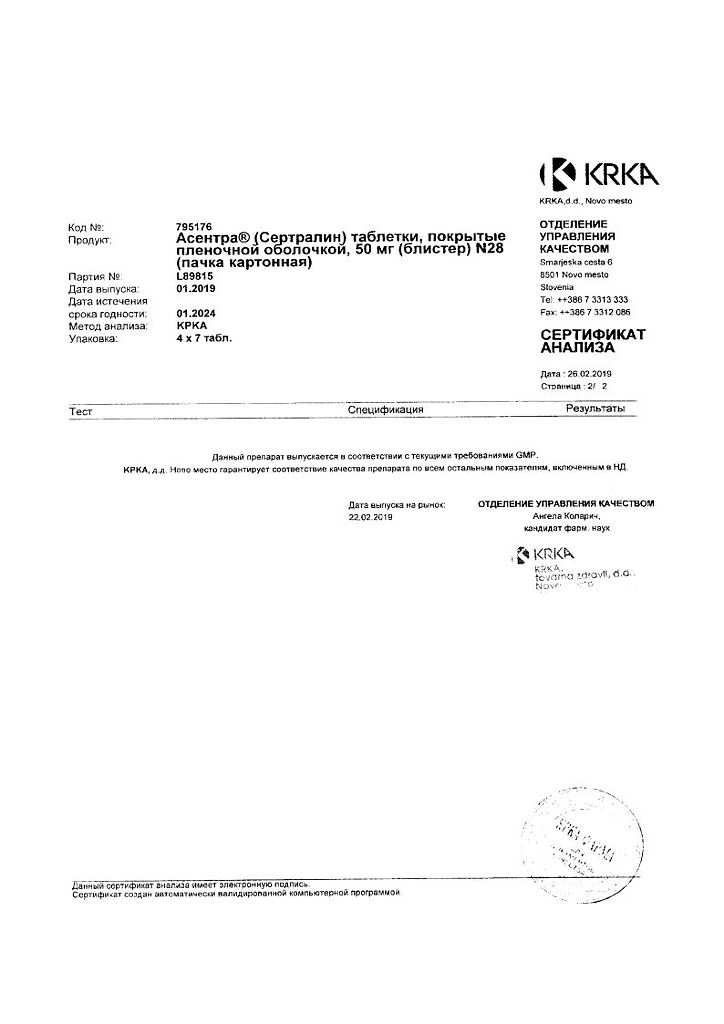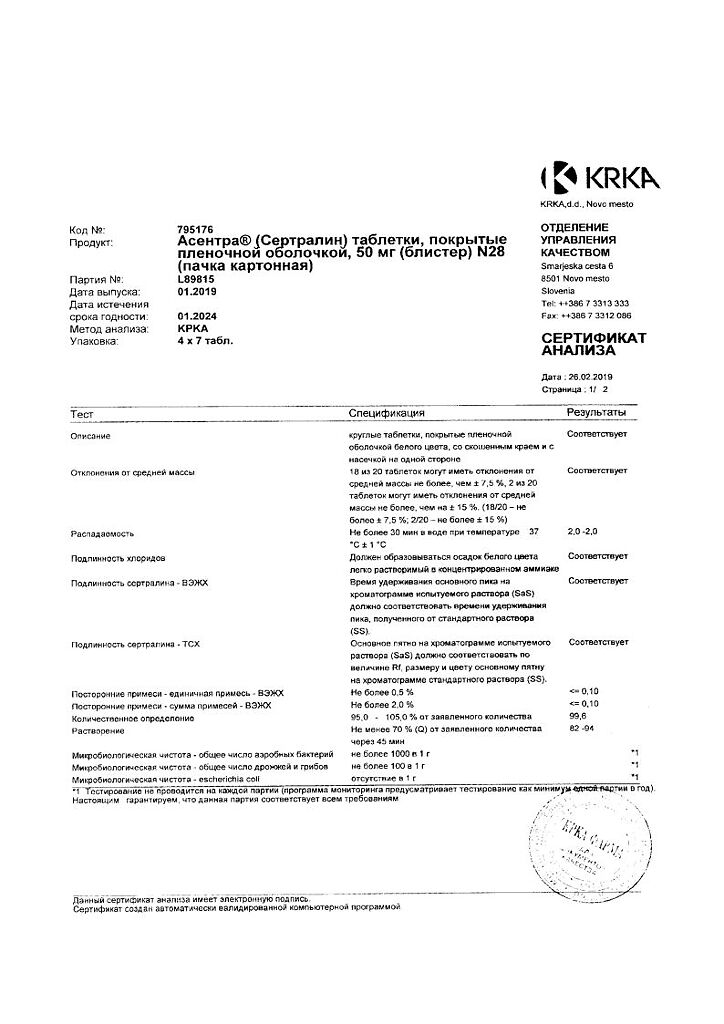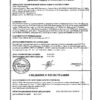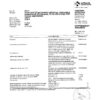No products in the cart.
Asentra, 50 mg 28 pcs.
€5.07 €4.51
Out of stock
(E-mail when Stock is available)
Description
An antidepressant. Specific inhibitor of serotonin reuptake (5-NT) in neurons. Effects on norepinephrine and dopamine metabolism are insignificant.
In therapeutic doses, sertraline blocks serotonin uptake in human platelets. The drug has no stimulant, sedative or anticholinergic effect.
It has no affinity for serotonin, dopamine, histamine, benzodiazepine, GABA, choline and adrenoreceptors.
The antidepressant effect is noted by the end of the second week of regular Asentra administration, while the maximum effect is not reached until 6 weeks.
In contrast to tricyclic antidepressants, there is no increase in body weight when prescribing Asentra; in some cases a decrease in body weight has been noted.
The drug does not cause mental or physical drug dependence.
Indications
Indications
Treatment and prevention of depression of various etiologies.
Treatment of obsessive-compulsive disorders (OCD).
Treatment of panic disorders.
Post-traumatic stress disorder (PTSD).
Pharmacological effect
Pharmacological effect
Antidepressant. A specific inhibitor of serotonin (5-HT) reuptake in neurons. The metabolism of norepinephrine and dopamine is slightly affected.
At therapeutic doses, sertraline blocks the uptake of serotonin into human platelets. The drug does not have a stimulating, sedative or anticholinergic effect.
Has no affinity for serotonin, dopamine, histamine, benzodiazepine, GABA, cholinergic and adrenergic receptors.
The antidepressant effect is observed by the end of the second week of regular use of Asentra, while the maximum effect is achieved only after 6 weeks.
Unlike tricyclic antidepressants, Asentra does not cause weight gain; in a number of cases its decrease was noted.
The drug does not cause mental or physical drug dependence.
Special instructions
Special instructions
According to clinical studies, the drug sertraline is effective and safe in the treatment of depression in patients who have suffered a myocardial infarction and in patients with unstable angina. Placebo-controlled studies have shown the effectiveness and safety of sertraline in patients with diabetes mellitus.
Sertraline is not prescribed together with MAO inhibitors, or within 14 days after stopping treatment with MAO inhibitors; After discontinuation of sertraline, MAO inhibitors are not prescribed for 14 days.
Patients with depression are at risk for suicide attempts. This danger persists until remission develops. Therefore, from the start of treatment until the optimal clinical effect is achieved, constant medical monitoring of the patient should be established. Currently, there is insufficient experience with the use of sertraline in patients undergoing electroconvulsive therapy. The possible success or risk of this combination treatment has not been studied.
Impact on the ability to drive vehicles and operate machinery
The administration of sertraline is not accompanied by impairment of psychomotor functions. However, its use simultaneously with other drugs can lead to impairment of attention and coordination of movements. Therefore, driving or engaging in activities associated with increased risk is not recommended during sertraline therapy.
Active ingredient
Active ingredient
Sertraline
Composition
Composition
1 tablet contains:
Active substances:
sertraline hydrochloride 55.95 mg, which corresponds to the content of sertraline – 50 mg.
Excipients:
magnesium stearate,
hydroxypropylcellulose,
sodium starch glycolate,
calcium dihydrogen phosphate,
microcrystalline cellulose,
talc.
Shell composition:
Opadry 03H28758 (hypromellose, titanium dioxide, talc, propylene glycol).
Pregnancy
Pregnancy
Adequate and strictly controlled clinical studies on the safety of sertraline during pregnancy have not been conducted. Prescribing the drug is possible only if the expected benefit to the mother outweighs the potential risk to the fetus.
Women of childbearing age should be advised to use effective contraception during the period of use of the drug.
Sertraline is found in breast milk. If it is necessary to prescribe the drug during lactation, breastfeeding should be stopped due to the lack of reliable data on the safety of sertraline use during this period.
Contraindications
Contraindications
Concomitant use of MAO inhibitors and for 14 days after their discontinuation.
Concomitant use of tryptophan or fenfluramine.
Unstable epilepsy.
Children’s age up to 6 years.
Pregnancy.
Lactation (breastfeeding).
Hypersensitivity to the components of the drug.
With caution: the drug is prescribed for neurological disorders (including mental retardation), manic states, epilepsy, liver and/or kidney failure, weight loss, children over 6 years of age.
Side Effects
Side Effects
From the central nervous system and peripheral nervous system: dry mouth, increased sweating, drowsiness, headache, dizziness, tremor, anxiety, agitation, hypomania, mania, insomnia, decreased appetite (rarely increased), up to anorexia, weakness, restlessness.
From the digestive system: flatulence, nausea, vomiting, diarrhea, abdominal pain; rarely (0.8%) with long-term use – an asymptomatic increase in transaminase activity in the blood serum (normalized when the drug is discontinued).
Other: visual disturbances, redness of the skin, ejaculation disorders, decreased libido, weight loss.
From laboratory parameters: reversible hyponatremia (more often in elderly people, as well as when taking diuretics or a number of other drugs) associated with the syndrome of inappropriate ADH secretion.
When using the drug in isolated cases, extrapyramidal disorders, dyskinesia, tremor, convulsions, menstrual irregularities, hyperprolactinemia, galactorrhea, and skin rash were noted; occasionally – erythema multiforme. Motor disorders were more often observed in patients with indications of their presence in the anamnesis or with concomitant use of antipsychotic drugs.
When you stop using the drug, withdrawal syndrome rarely occurs. Paresthesia, hypoesthesia, symptoms of depression, hallucinations, aggressive reactions, psychomotor agitation, anxiety or symptoms of psychosis are possible. These manifestations are difficult to differentiate from the symptoms of the underlying disease, and they can occur when using other antidepressants.
Interaction
Interaction
With the simultaneous use of sertraline and MAO inhibitors (including selective MAO inhibitors with a reversible type of action – selegiline and moclobemide), the development of serotonin syndrome is possible: hyperthermia, rigidity, myoclonus, lability of the autonomic nervous system (rapid fluctuations in the parameters of the respiratory and cardiovascular system), changes in mental status, including increased irritability, severe agitation, confusion consciousness, which in some cases can turn into a delirious state or coma (this combination is contraindicated). Similar complications (sometimes fatal) occur when MAO inhibitors are prescribed during treatment with antidepressants that inhibit the neuronal uptake of monoamines or immediately after their withdrawal.
In healthy volunteers, the use of sertraline at a dose of 200 mg / day does not affect the effect of ethanol, carbamazepine or haloperidol, as well as mental activity and psychomotor activity (however, the combined administration of sertraline and drugs that depress the central nervous system requires close attention, and simultaneous use with ethanol and ethanol-containing drugs is contraindicated).
When indirect anticoagulants (coumarin derivatives) are co-administered with sertraline, a significant increase in prothrombin time is observed (monitoring of prothrombin time is required at the beginning of sertraline use and after its discontinuation).
Pharmacokinetic interaction
When used together, sertraline may interact with other drugs that bind to plasma proteins (diazepam, tolbutamide and warfarin).
Concomitant use of the drug with cimetidine significantly reduces the clearance of sertraline.
Long-term use of sertraline at a dose of 50 mg/day with desipramine (a drug metabolized by the CYP2D6 isoenzyme) is accompanied by an increase in the concentration of desipramine in the blood plasma.
In vitro experiments have shown that the beta-hydroxylation of endogenous cortisol carried out by the CYP3A3/4 isoenzyme, as well as the metabolism of carbamazepine and terfenadine, do not change with long-term administration of sertraline at a dose of 200 mg/day.
The plasma concentrations of tolbutamide, phenytoin and warfarin do not change with long-term administration of sertraline at a dose of 200 mg/day, therefore, we can conclude that sertraline does not inhibit the CYP2C9 isoenzyme.
Sertraline does not affect the concentration of diazepam in the blood serum, which indicates the absence of inhibition of the CYP2C19 isoenzyme.
According to in vitro studies, sertraline has virtually no effect or minimal inhibition of the CYP1A2 isoenzyme.
The pharmacokinetics of lithium do not change statistically significantly with concomitant administration of sertraline; but tremor is observed more frequently, suggesting the possibility of a pharmacodynamic interaction (this combination requires caution). Sertraline should also be administered with caution with other drugs that affect serotonergic transmission.
When replacing one neuronal uptake inhibitor with another, there is no need for a washout period. However, caution is required when changing the course of treatment. Co-administration of tryptophan or fenfluramine with sertraline should be avoided.
Clinical studies have shown that sertraline causes minimal induction of liver enzymes. Simultaneous administration of sertraline at a dose of 200 mg and antipyrine leads to a significant decrease in T1/2 of antipyrine (this change is detected in only 5% of observations).
When administered together, sertraline does not affect the beta-blocking effect of atenolol.
When sertraline was administered in a daily dose of 200 mg, no drug interactions with glibenclamide and digoxin were detected.
Overdose
Overdose
Symptoms: serotonin syndrome may occur with nausea, vomiting, drowsiness, tachycardia, agitation, dizziness, psychomotor agitation, diarrhea, increased sweating, myoclonus, hyperreflexia. No severe symptoms were detected even when using the drug in high doses. However, when taken simultaneously with other drugs or ethanol, severe poisoning can occur, sometimes fatal.
Treatment: There are no specific antidotes. If necessary, intensive supportive care and monitoring of the state of the vital functions of the body. The introduction of activated carbon may be more effective than gastric lavage; inducing artificial vomiting is not recommended. The airway must be maintained. Forced diuresis, dialysis, hemoperfusion or blood transfusion may be unsuccessful (due to the large volume of distribution of sertraline).
Storage conditions
Storage conditions
At a temperature not exceeding 25 °C
Shelf life
Shelf life
5 years
Manufacturer
Manufacturer
KRKA dd Novo Mesto, Slovenia
Additional information
| Shelf life | 5 years |
|---|---|
| Conditions of storage | At a temperature not exceeding 25 °C |
| Manufacturer | KRKA dd Novo mesto, Slovenia |
| Medication form | pills |
| Brand | KRKA dd Novo mesto |
Related products
Buy Asentra, 50 mg 28 pcs. with delivery to USA, UK, Europe and over 120 other countries.






















